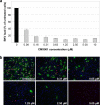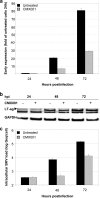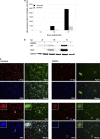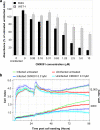1-O-hexadecyloxypropyl cidofovir (CMX001) effectively inhibits polyomavirus BK replication in primary human renal tubular epithelial cells
- PMID: 20713664
- PMCID: PMC2976161
- DOI: 10.1128/AAC.00974-10
1-O-hexadecyloxypropyl cidofovir (CMX001) effectively inhibits polyomavirus BK replication in primary human renal tubular epithelial cells
Abstract
Antiviral drugs for treating polyomavirus BK (BKV) replication in polyomavirus-associated nephropathy or hemorrhagic cystitis are of considerable clinical interest. Unlike cidofovir, the lipid conjugate 1-O-hexadecyloxypropyl cidofovir (CMX001) is orally available and has not caused detectable nephrotoxicity in rodent models or human studies to date. Primary human renal proximal tubular epithelial cells were infected with BKV-Dunlop, and CMX001 was added 2 h postinfection (hpi). The intracellular and extracellular BKV DNA load was determined by quantitative PCR. Viral gene expression was examined by quantitative reverse transcription-PCR, Western blotting, and immunofluorescence microscopy. We also examined host cell viability, proliferation, metabolic activity, and DNA replication. The titration of CMX001 identified 0.31 μM as the 90% effective concentration (EC(90)) for reducing the extracellular BKV load at 72 hpi. BKV large T antigen mRNA and protein expression was unaffected at 24 hpi, but the intracellular BKV genome was reduced by 90% at 48 hpi. Late gene expression was reduced by 70 and 90% at 48 and 72 hpi, respectively. Comparisons of CMX001 and cidofovir EC(90)s from 24 to 96 hpi demonstrated that CMX001 had a more rapid and enduring effect on BKV DNA and infectious progeny at 96 hpi than cidofovir. CMX001 at 0.31 μM had little effect on overall cell metabolism but reduced bromodeoxyuridine incorporation and host cell proliferation by 20 to 30%, while BKV infection increased cell proliferation in both rapidly dividing and near-confluent cultures. We conclude that CMX001 inhibits BKV replication with a longer-lasting effect than cidofovir at 400× lower levels, with fewer side effects on relevant host cells in vitro.
Figures





Similar articles
-
Cidofovir inhibits polyomavirus BK replication in human renal tubular cells downstream of viral early gene expression.Am J Transplant. 2008 Jul;8(7):1413-22. doi: 10.1111/j.1600-6143.2008.02269.x. Am J Transplant. 2008. PMID: 18510636
-
Antiviral effects of artesunate on polyomavirus BK replication in primary human kidney cells.Antimicrob Agents Chemother. 2014;58(1):279-89. doi: 10.1128/AAC.01800-13. Epub 2013 Oct 21. Antimicrob Agents Chemother. 2014. PMID: 24145549 Free PMC article.
-
CMX001 (1-O-hexadecyloxypropyl-cidofovir) inhibits polyomavirus JC replication in human brain progenitor-derived astrocytes.Antimicrob Agents Chemother. 2011 May;55(5):2129-36. doi: 10.1128/AAC.00046-11. Epub 2011 Mar 14. Antimicrob Agents Chemother. 2011. PMID: 21402853 Free PMC article.
-
Polyomavirus BK.Lancet Infect Dis. 2003 Oct;3(10):611-23. doi: 10.1016/s1473-3099(03)00770-9. Lancet Infect Dis. 2003. PMID: 14522260 Review.
-
Low-dose cidofovir for the treatment of polyomavirus-associated nephropathy: two case reports and review of the literature.Antivir Ther. 2008;13(8):1001-9. Antivir Ther. 2008. PMID: 19195325 Review.
Cited by
-
Relationship of BK polyoma virus (BKV) in the urine with hemorrhagic cystitis and renal function in recipients of T Cell-depleted peripheral blood and cord blood stem cell transplantations.Biol Blood Marrow Transplant. 2014 Aug;20(8):1204-10. doi: 10.1016/j.bbmt.2014.04.017. Epub 2014 Apr 23. Biol Blood Marrow Transplant. 2014. PMID: 24769326 Free PMC article.
-
Characterization of Immunodominant BK Polyomavirus 9mer Epitope T Cell Responses.Am J Transplant. 2016 Apr;16(4):1193-206. doi: 10.1111/ajt.13598. Epub 2016 Feb 17. Am J Transplant. 2016. PMID: 26663765 Free PMC article.
-
BK Polyomavirus Infection in Kidney Transplantation: A Comprehensive Review of Current Challenges and Future Directions.Int J Mol Sci. 2024 Nov 28;25(23):12801. doi: 10.3390/ijms252312801. Int J Mol Sci. 2024. PMID: 39684510 Free PMC article. Review.
-
New immunosuppressive agents in pediatric transplantation.Clinics (Sao Paulo). 2014;69 Suppl 1(Suppl 1):8-16. doi: 10.6061/clinics/2014(sup01)03. Clinics (Sao Paulo). 2014. PMID: 24860853 Free PMC article. Review.
-
BK Polyomavirus bkv-miR-B1-5p: A Stable Micro-RNA to Monitor Active Viral Replication after Kidney Transplantation.Int J Mol Sci. 2022 Jun 29;23(13):7240. doi: 10.3390/ijms23137240. Int J Mol Sci. 2022. PMID: 35806242 Free PMC article.
References
-
- Bernhoff, E., T. J. Gutteberg, K. Sandvik, H. H. Hirsch, and C. H. Rinaldo. 2008. Cidofovir inhibits polyomavirus BK replication in human renal tubular cells downstream of viral early gene expression. Am. J. Transplant. 8:1413-1422. - PubMed
-
- Binet, I., V. Nickeleit, H. H. Hirsch, O. Prince, P. Dalquen, F. Gudat, M. J. Mihatsch, and G. Thiel. 1999. Polyomavirus disease under new immunosuppressive drugs: a cause of renal graft dysfunction and graft loss. Transplantation 67:918-922. - PubMed
-
- Binggeli, S., A. Egli, S. Schaub, I. Binet, M. Mayr, J. Steiger, and H. H. Hirsch. 2007. Polyomavirus BK-specific cellular immune response to VP1 and large T-antigen in kidney transplant recipients. Am. J. Transplant. 7:1131-1139. - PubMed
-
- Cole, C. N. 1996. Polyomavirinae: the viruses and their replication, p. 917-945. In D. M. K. Bernard, N. Fields, and Peter M. Howley (ed.), Fundamental virology, 3rd ed. Lippincott-Raven Publishers, Philadelphia, PA.
Publication types
MeSH terms
Substances
LinkOut - more resources
Full Text Sources
Other Literature Sources

